The Microsoft Surface Pro 4 Review: Raising The Bar
by Brett Howse on October 21, 2015 9:00 AM ESTBattery Life
One of the trade-offs that Microsoft has made with the Surface Pro 4 is a reduction in battery capacity. Ever since the first Surface Pro was launched, Microsoft has equipped it with a 42 Watt-hour battery. That is a large size for a tablet, but the Surface Pro has always been a larger than normal tablet too. With the Surface Pro 4, the battery capacity has been reduced slightly to 39 Wh. Part of this is the thinner chassis, and part of it is the new hybrid cooling which puts a copper plate over the battery. I can’t argue with the new cooling system, since it has clearly made a big difference in thermals.
To take a look at battery life, I’ve run both our tablet battery tests and our notebook battery tests. As with all of our battery life testing, the display is set to 200 nits for a consistent result across devices.
Tablet Battery Life
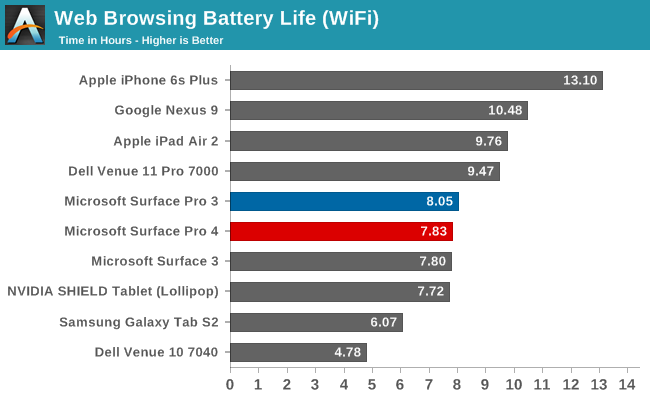
Looking at our tablet web browsing test, the Surface Pro 4 comes in right around the same battery life of the Surface Pro 3, running out of power about 13 minutes sooner. When you think about the move to Skylake, this could be taken as a disappointment, and I honestly thought it might be able to get a bit more. But the smaller battery capacity and increased pixel density both negatively impact batter life despite the CPU using a bit less power itself. I would have loved to see the larger battery stay, which would have given it about 8.5 hours, but the improved cooling system is likely a better trade-off compared to around 30 minutes of battery life.
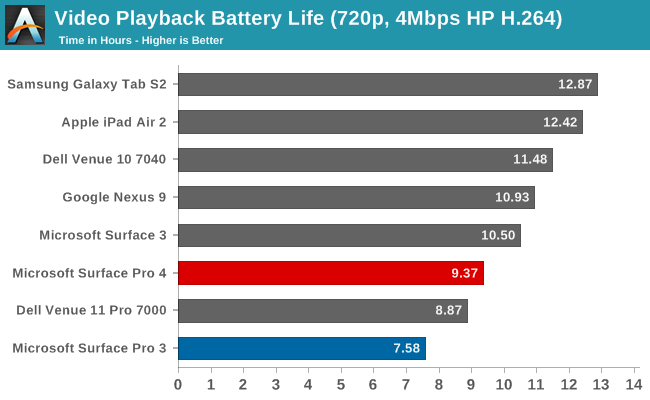
Once we shift to a more CPU-intensive workload however we start seeing significant gains. Intel has been making good progress on their video decode power consumption since Haswell, and the Surface Pro 4, despite the greater pixel density and a smaller battery, achieves 23% longer battery life than the Surface Pro 3 at this task. This is a great result and puts the Surface Pro 4 more in line with what traditional ARM based tablets can achieve.
Notebook Battery Life
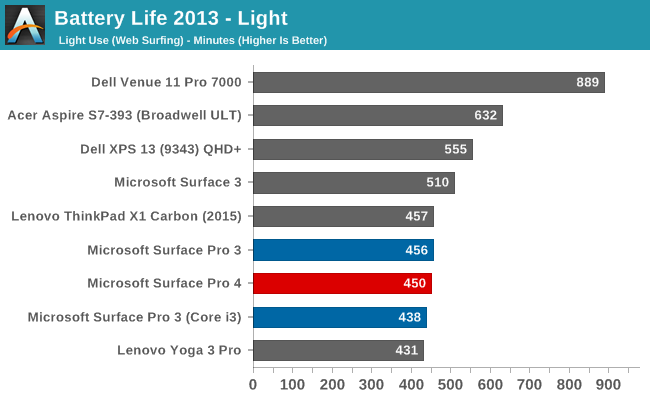
Once again the Surface Pro 4 falls right in line with the previous generations for battery life, which means that the efficiency has been improved even though the panel is much denser. While certainly not class leading in overall life, for the size of device and performance available, it is a pretty good result. Being able to keep battery life flat, while improving the display resolution, and making the device thinner and lighter, is in line with what you would expect as they pack more and more power efficient parts into the Surface Pro 4.
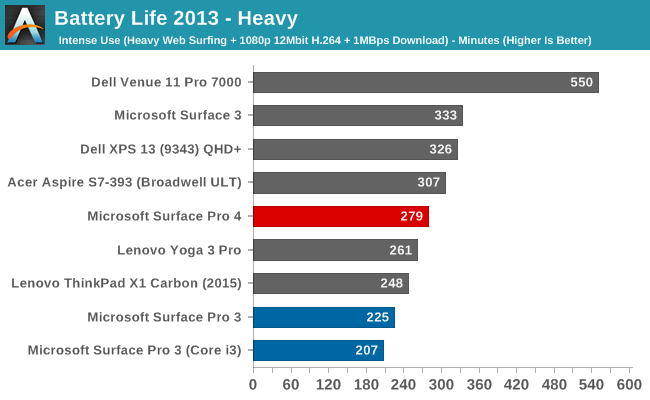
Under our heavy battery life test we can really see the improvements with Skylake. The Surface Pro 4 battery life score on our heavy battery life test outlasts the Surface Pro 3 by 21%. The heavy test involves video playback, which we have just seen in the tablet workload is significantly improved, as well as a much higher web load and a 1 MB/s file download. Once again, the Surface Pro 4 is not going to be able to compete with notebooks with much larger batteries, but for the size and weight of the device, it is a good result.
Next up let’s break down our results by energy efficiency.

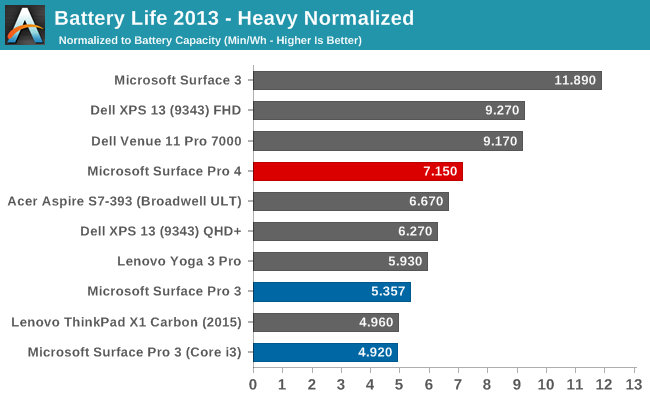
The XPS 13 is the class leader in battery life at the moment, but it achieves this with the 1920x1080 display. In order to be more comparable to the Surface Pro 4, the graph shows the higher resolution 3200x1800 version which was still able to get some pretty good battery life scores. The Surface Pro 4 manages to be more efficient than every other high resolution device we have tested, although lower resolution devices are still able to offer greater overall efficiency.
Charge Time
Microsoft has kept the same charging system from the Surface Pro 3, with the Surface Connect port providing the connection. This hasn’t changed since the last model, but I do like the magnetic connector and how well it always attaches. I kind of wish Microsoft had added a USB-C here as well, but the Surface Connect port is a pretty nice implementation. Unsurprisingly then, the charge time does not change very much at all compared to last year’s model.
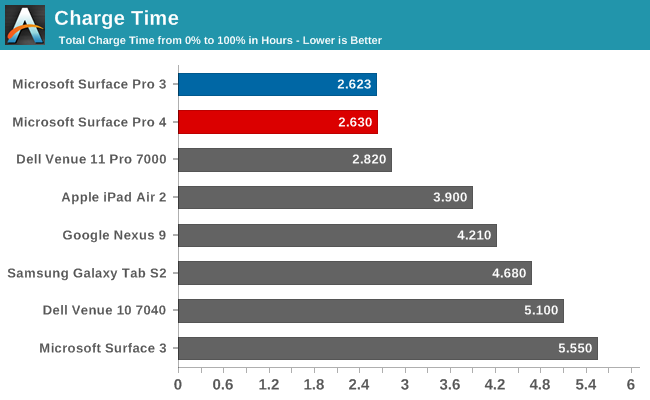
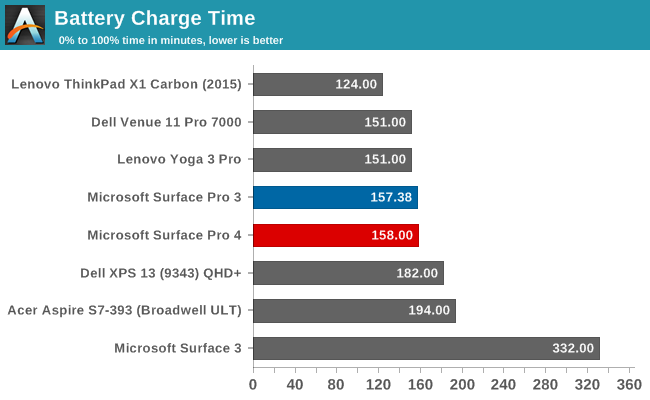
I recorded a 158-minute charge time with the standard charger. Microsoft also offers a higher wattage 60 W version for use with the Surface Book, and you can also purchase it as an accessory for the Surface Pro 4. The result with that charger? 158 minutes. The Surface Pro 4 did not dump any extra power to the battery at all with the higher wattage charger.
Once other nice part of the Surface Pro 4 charger, which also carries over, is the included 5 W USB port on the charger itself, so you can charge up your smartphone without burning two outlets. It’s a small thing, but when you are at a hotel where outlets on the desk are at a premium, it’s nice to be able to do this.


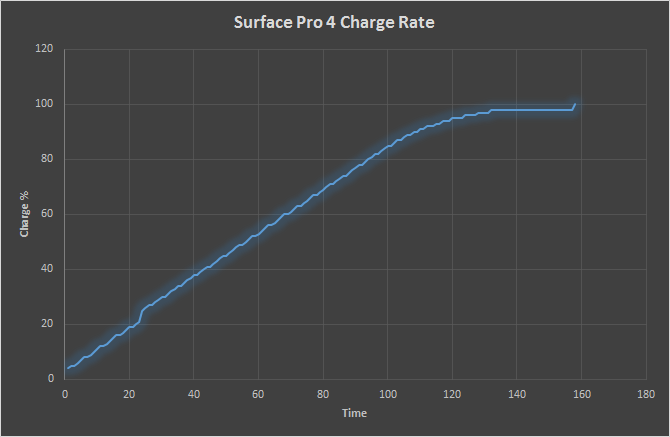








175 Comments
View All Comments
robl - Wednesday, October 21, 2015 - link
Great review - I like how you've expanded your comparison across more tiers of devices. I'm constantly trying to judge "do I need to put the tablet or phone down and use my PC as it's much faster?". I'd recommend you expand it a bit and show the tiers on each test, such as high end desk top, ultra portables, surface, phones.euskalzabe - Wednesday, October 21, 2015 - link
"Core i5 with a 256 GB SSD and 8 GB of RAM - for $1299. That is the price of a good Ultrabook"I keep being puzzled by this kind of statement lately. I just bought an Asus UX305LA, not the Core M version, an i5-5200U with 256BG SSD and 8GB RAM. It cost me $750. It's built of aluminum. Most reviews praised everything in the Core-M UX305 except the CPU power. The i5 version hast it all: CPU, RAM, SSD.
Why are most tech sites still pretending one needs $1K+ to get a decent ultrabook? The UX305LA costs $250 less and it's a great ultrabook for a great price.
I just don't get it. Is Asus being shunned or something? Somebody please explain.
Mushkins - Wednesday, October 21, 2015 - link
Because you're not measuring by the same metrics. Sure, you got an i5-5200U with a 256GB SSD and 8GB of ram for $750. But it's also not in a tablet form factor, weighs almost 3 lbs, no touch screen and no native stylus input. By that note I could get a full mobile i7 with a discrete GPU and a 17" monitor for less than $1000 too, or a powerhouse desktop that blows them all away for less than $800.You're focusing on compute power per dollar, they're focusing on portability and form factor. You're not going to get sub-2lbs with a touch screen and this kind of processing power for less than $1000.
euskalzabe - Thursday, October 22, 2015 - link
Hmmm, that makes a lot of sense, thanks. I definitely am thinking on compute power per dollar terms. I guess once ultrabooks got to Macbook Air levels of portability, that's portable enough, for ME. So, once that point was reached, I don't need to pay more and started thinking of performance per dollar. I could use something more portable, but 2.6 pounds is light enough for my use.You perfectly clarified why I think how I think. Thanks for letting me see that :)
TallestJon96 - Wednesday, October 21, 2015 - link
Never bought or looked into surfaces much, but this is damn impressive. The form factor is the best I've seen, performance is surprisingly good, the screen seems fantastic, and storage is blazing fast.There are some downsides though. At this price, DDR4 should be used (what's the difference, $10?) that would put graphics performance up another notch. Also, at least 1 USB C should exist. And battery life is good, and better at heavy loads, but if it was better at everything jt would feel better.
As it is right now, pricing is ridiculous in the sense that they charge $200 to go from 8 to 16gb RAM, or $400 to go from 256gb storage to 512gb. The margins on those upgrades must be 50-80%.
Ridiculous pricing scheme aside, the i5 with 8gb and 256gb is a decent value, the m3 model is pretty cool, and if you are willing to pay top dollar, the highest end models can't be beat. I think the surface exemplifies what is possible in 2015 the same way the MacBook Air did around 2012.
Mushkins - Wednesday, October 21, 2015 - link
You're definitely paying a premium for the hardware, but the SP3, the macbook air, etc are all competing in the same premium product space. It's just the nature of the beast, though I guess we have to stop calling it the "apple tax" these days.Zoldyck - Wednesday, October 21, 2015 - link
Great article, but would you mind adding graphics benchmarks of Surface Pro 4 i7-6650U , and how it compares to Surface Book with dgpu?jaime4272 - Wednesday, October 21, 2015 - link
I was thinking the same thing about a benchmark for the pro 4 i7 6650U Iris 540 256gb 16gb ram. I pre order one. I was looking at the high end low end and this was the onedigiguy - Wednesday, October 21, 2015 - link
See the reply by Brett to my similar question above....wintermute000 - Thursday, October 22, 2015 - link
wonder with that anemic GPU whether it would have been better to make it non-convertible and include an Iris Pro instead